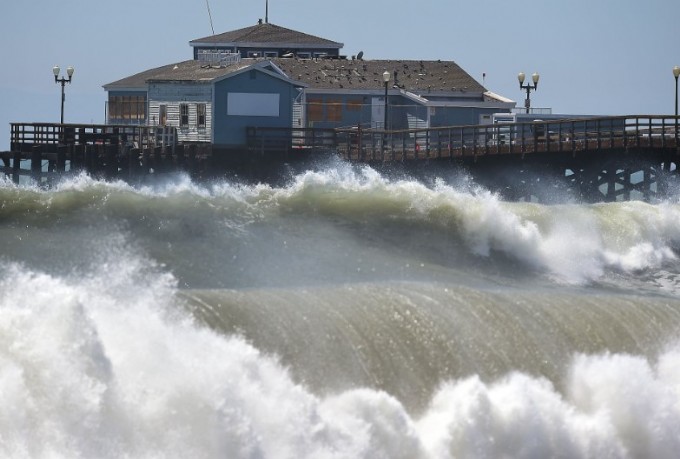Fabulous
Debunking the Myth: No, Florida Won't Face a Category 6 Hurricane Despite 'Time-Traveling' TikToker's Claims
However, this prediction contradicts the established Saffir-Simpson Scale, which rates hurricanes up to Category 5. While the idea of a Category 6 hurricane has surfaced before, experts and scientists have debunked its feasibility.
Questionable Prediction: A TikTok video claiming to be from a 'time traveler' has circulated, forecasting a Category 6 hurricane impacting Florida and the Carolinas on September 4. Despite the intriguing time travel concept, the prediction faces a significant hurdle—the absence of a Category 6 designation on the Saffir-Simpson Scale used to classify hurricane intensity.
The Illusive Category 6: While the notion of a storm surpassing the ferocity of a Category 5 hurricane has been discussed, a Category 6 hurricane remains nonexistent in the Saffir-Simpson Scale. Attempts to introduce this additional category have arisen over the years, particularly after extreme storms like Hurricane Irma in 2017, with winds reaching 185 mph.
Sizing Up the Scale: The Saffir-Simpson Hurricane Scale, devised by Herbert Saffir and Robert Simpson in 1971, provides a rating from 1 to 5 based on sustained wind speeds. It was established to convey the potential damage caused by hurricanes. However, it currently concludes at Category 5, which encompasses winds exceeding 155 mph.
Unnecessary Complexity: Robert Homer Simpson, one of the scale's co-developers, expressed that extending the scale was unwarranted. Despite discussions on strengthening the hurricane classification system to address storms with winds surpassing 155 mph, Simpson maintained that such an extension wouldn't significantly enhance the scale's effectiveness.

Misconception and Clarity: The concept of Category 6 hurricanes has led to misconceptions and debates. It's vital to understand that the Saffir-Simpson Scale's existing categories aptly encompass the potential damage caused by storms exceeding 155 mph winds. The scale provides a concise and effective method to assess hurricane strength and potential destruction.
Defying the Myth: Disputing the notion of Category 6 hurricanes, experts underline the sufficiency of the current classification system. Regardless of wind speeds exceeding 155 mph, a storm's intensity is comprehensively captured within the existing categories. Hence, the fascination with Category 6 hurricanes appears to be an unnecessary complication in the world of hurricane science.
Expanding upon this topic further, it's important to consider the historical context in which the Saffir-Simpson Scale was developed. In the early 1970s, when hurricanes were a significant threat to coastal areas, the need for a standardized classification system became evident. Herbert Saffir and Robert Simpson's collaboration resulted in the creation of the now-familiar scale, which accounts for factors such as wind speed and potential damage. This classification system aimed to assist emergency responders, policymakers, and the general public in understanding the potential impact of an approaching hurricane.
Over the years, hurricanes have left devastating marks on various regions, prompting discussions about whether the existing scale should be expanded to include a Category 6 designation. The desire to accommodate the growing intensity of storms, like Hurricane Irma, which exhibited wind speeds that approached those of a hypothetical Category 6 hurricane, has fueled these debates. However, the question remains: Is a Category 6 designation truly necessary?
Proponents of the current classification system argue that the distinction between Category 5 and a potential Category 6 might not significantly alter the preparations and responses required for such storms. The existing scale already conveys the severe damage potential of a hurricane with winds exceeding 155 mph, and emergency measures are often similar for these high-intensity storms regardless of whether they are labeled as Category 5 or 6. Thus, the effectiveness of the scale in conveying crucial information remains intact.
It's important to recognize that while the concept of a Category 6 hurricane might capture the imagination and stir curiosity, the practical implications of introducing such a designation could be limited. The Saffir-Simpson Scale's primary purpose is to provide a clear, concise, and understandable assessment of hurricane intensity, aiding both professionals and the public in making informed decisions.
In conclusion, the fascination with the idea of a Category 6 hurricane continues to spark debates and discussions, especially in the age of social media where even speculative predictions gain attention. However, the established Saffir-Simpson Scale, with its well-defined categories up to Category 5, remains a tried-and-true tool for assessing hurricane intensity and potential damage. While the concept of a Category 6 storm captures the imagination, the scale's existing categories effectively convey the necessary information and help streamline emergency responses, making the addition of a Category 6 designation an unnecessary complexity in the world of hurricane science.
Latest News
However, this prediction contradicts the established Saffir-Simpson Scale, which rates hurricanes up to Category 5. While the idea of a Category 6 hurricane has surfaced before, experts and scientists have debunked its feasibility.
Questionable Prediction: A TikTok video claiming to be from a 'time traveler' has circulated, forecasting a Category 6 hurricane impacting Florida and the Carolinas on September 4. Despite the intriguing time travel concept, the prediction faces a significant hurdle—the absence of a Category 6 designation on the Saffir-Simpson Scale used to classify hurricane intensity.
The Illusive Category 6: While the notion of a storm surpassing the ferocity of a Category 5 hurricane has been discussed, a Category 6 hurricane remains nonexistent in the Saffir-Simpson Scale. Attempts to introduce this additional category have arisen over the years, particularly after extreme storms like Hurricane Irma in 2017, with winds reaching 185 mph.
Sizing Up the Scale: The Saffir-Simpson Hurricane Scale, devised by Herbert Saffir and Robert Simpson in 1971, provides a rating from 1 to 5 based on sustained wind speeds. It was established to convey the potential damage caused by hurricanes. However, it currently concludes at Category 5, which encompasses winds exceeding 155 mph.
Unnecessary Complexity: Robert Homer Simpson, one of the scale's co-developers, expressed that extending the scale was unwarranted. Despite discussions on strengthening the hurricane classification system to address storms with winds surpassing 155 mph, Simpson maintained that such an extension wouldn't significantly enhance the scale's effectiveness.

Misconception and Clarity: The concept of Category 6 hurricanes has led to misconceptions and debates. It's vital to understand that the Saffir-Simpson Scale's existing categories aptly encompass the potential damage caused by storms exceeding 155 mph winds. The scale provides a concise and effective method to assess hurricane strength and potential destruction.
Defying the Myth: Disputing the notion of Category 6 hurricanes, experts underline the sufficiency of the current classification system. Regardless of wind speeds exceeding 155 mph, a storm's intensity is comprehensively captured within the existing categories. Hence, the fascination with Category 6 hurricanes appears to be an unnecessary complication in the world of hurricane science.
Expanding upon this topic further, it's important to consider the historical context in which the Saffir-Simpson Scale was developed. In the early 1970s, when hurricanes were a significant threat to coastal areas, the need for a standardized classification system became evident. Herbert Saffir and Robert Simpson's collaboration resulted in the creation of the now-familiar scale, which accounts for factors such as wind speed and potential damage. This classification system aimed to assist emergency responders, policymakers, and the general public in understanding the potential impact of an approaching hurricane.
Over the years, hurricanes have left devastating marks on various regions, prompting discussions about whether the existing scale should be expanded to include a Category 6 designation. The desire to accommodate the growing intensity of storms, like Hurricane Irma, which exhibited wind speeds that approached those of a hypothetical Category 6 hurricane, has fueled these debates. However, the question remains: Is a Category 6 designation truly necessary?
Proponents of the current classification system argue that the distinction between Category 5 and a potential Category 6 might not significantly alter the preparations and responses required for such storms. The existing scale already conveys the severe damage potential of a hurricane with winds exceeding 155 mph, and emergency measures are often similar for these high-intensity storms regardless of whether they are labeled as Category 5 or 6. Thus, the effectiveness of the scale in conveying crucial information remains intact.
It's important to recognize that while the concept of a Category 6 hurricane might capture the imagination and stir curiosity, the practical implications of introducing such a designation could be limited. The Saffir-Simpson Scale's primary purpose is to provide a clear, concise, and understandable assessment of hurricane intensity, aiding both professionals and the public in making informed decisions.
In conclusion, the fascination with the idea of a Category 6 hurricane continues to spark debates and discussions, especially in the age of social media where even speculative predictions gain attention. However, the established Saffir-Simpson Scale, with its well-defined categories up to Category 5, remains a tried-and-true tool for assessing hurricane intensity and potential damage. While the concept of a Category 6 storm captures the imagination, the scale's existing categories effectively convey the necessary information and help streamline emergency responses, making the addition of a Category 6 designation an unnecessary complexity in the world of hurricane science.

Jennifer Lopez looks ageless in a towel in no-makeup video

Amanda Holden spanks her derriere and thanks Spanx

Amanda Holden shows off more than bargained as she dances around in her outfit of the day

Meet Harley Cameron, the stunning model who went from a BKFC ring girl to become a pro wrestler and found love

GreenGirlBella, Rocks Emirates Stadium in Painted Home Kit

Amanda Holden calls herself a 'good girl' in white dress with 'cheeky' split

Mum slammed by parents after flashing thong in school run outfit

Lottie Moss makes jaws dropp as she shows off her flawless body

Amanda Holden wears nothing beneath plunging white dress












Comments
Written news comments are in no way https://www.showbizglow.com it does not reflect the opinions and thoughts of. Comments are binding on the person who wrote them.